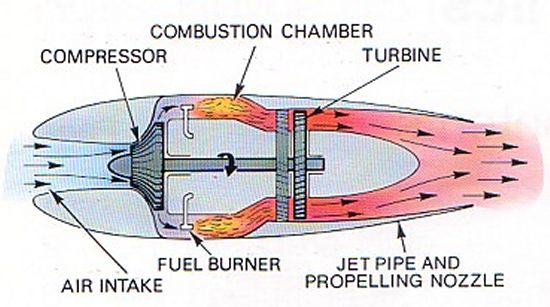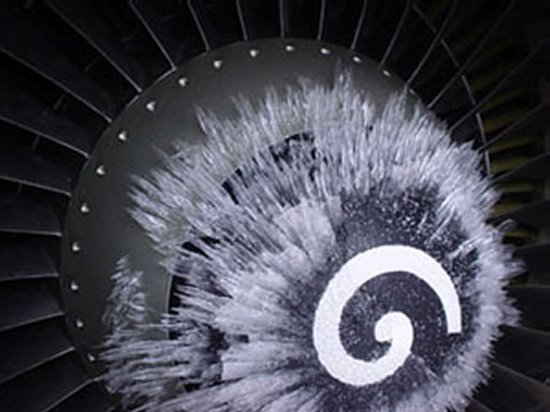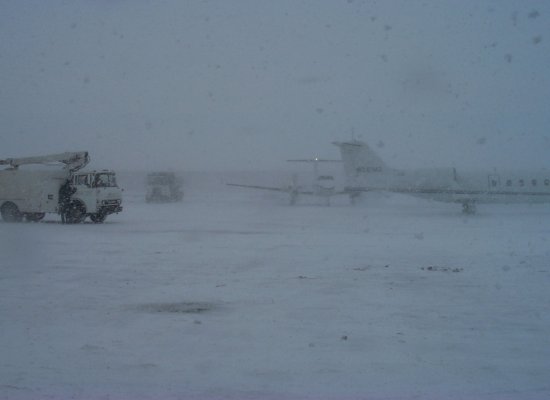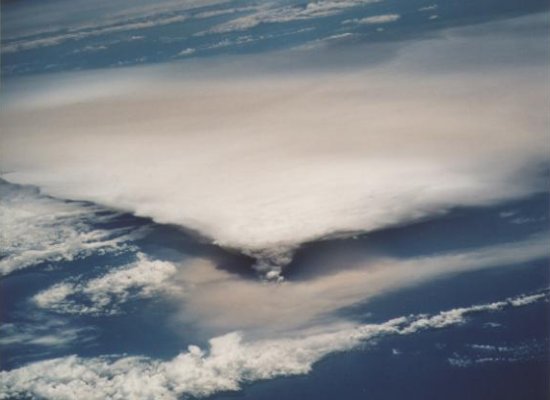|
||||||||||
| Location: Home > %7Eaerospa1 > ask a rocket scientist > propulsion > q0293 | ||||||||||
|
|
||||||||||
|
||||||||||
| Location: Home > %7Eaerospa1 > ask a rocket scientist > propulsion > q0293 | ||||||||||
|
|
||||||||||

The biggest danger posed by forms of precipitation like rain, snow, ice, or fog is an engine flameout. A flameout is defined as a loss of engine power that is not caused by a mechanical failure. The three items needed to keep a jet engine operating are fuel, air, and a source of heat to make them burn. Loss of any one of these three can result in a flameout. Flameouts are generally rare and occur only about once in every 100,000 non-military flights.
Not only are flameouts themselves rare, but precipitation is unlikely to be the cause of one. While rain can have an influence on the function of a jet engine, it is typically not a significant effect. The majority of storms produce light rain or snow that has little if any impact on an engine. Clouds are also made of small ice crystals that have no appreciable effect. In general, only very intense storms affect engine behavior and aircraft will usually make a detour to avoid storms this strong anyway. The fear is primarily because of turbulence that produces a very uncomfortable ride rather than engine performance problems. Even in a strong storm, however, the main consequence a jet engine experiences is a reduction in the efficiency of the combustion process. This efficiency is a function of the fuel-air ratio that is changed by the presence of water vapor.

This effect is negligible under most conditions since the percentage of water present in the large volume of air entering an engine is still relatively small in most storms. The high temperature in the engine's combustion chamber quickly evaporates this level of water into steam that has little influence on the engine's power output. Air also passes through the engine quite quickly since a typical engine on a commercial airliner cycles through a volume of air comparable to that in an average house each second.
Many turbofan engines also take advantage of their bypass air system to remove precipitation from the airflow before it reaches the combustion section. As the incoming air moves into the rotating fan blades, the spinning motion flings the heavier water outward like a centrifuge. The water is then blown through the bypass air ducts that surround the engine core. In this way, the water is carried through the engine without ever entering the combustion chamber. This design allows a turbofan engine to remove the majority of water that it will ever ingest while flying through a storm. Whatever small amount of water remains in the air passing through the core will be evaporated and can easily be handled by the engine.

The forms of precipitation that are most difficult to deal with are large hail, ice, and freezing rain. Large hail is only found in very strong storms that are generally avoided because of the turbulence problems discussed earlier, and hail impacts can also damage the engine or the aircraft's skin. Freezing rain is troublesome when it forms ice on the engine inlet or the center of the engine spinner. As the ice builds up, chunks may break off and enter the engine causing damage to fan blades or disrupting the airflow and combustion process. Ice is usually prevented by heating systems that warm the surfaces where ice is most likely and discourages its formation. The center hub of some engines is also covered in small sections of rubber that vibrate as ice starts to form causing the ice to shed before it grows into large and dangerous chunks. During freezing rain while sitting on the ground waiting for takeoff, pilots are also trained to rev the engines frequently to prevent ice accumulation.
Another design feature that helps keep a jet engine operating in heavy precipitation is igniters, similar to spark plugs, in the combustion section. In the event that the engine suffers a flameout, the igniters will re-ignite the fuel-air mix and restart the engine. Manufacturers recommend that igniters always be turned on whenever a plane's anti-icing equipment is in use or when flying through heavy storms to assist the combustion process. This practice is also recommended when taking off from a runway with standing water since the landing gear can throw up a sheet of water that may be ingested by the engines causing a flameout. Some modern engines are equipped with electronic systems that detect the state of the combustion process and tell the flight crew to engage the igniters. Engines may also have systems that turn the igniters on or restart the engine automatically.

Although rain and snow typically pose little danger of causing a flameout in flight, there have been a few cases when precipitation has resulted in engine failure. In August 1987, a Boeing 737 of Air Europe was descending through rain and hail to land in Greece when both of the plane's engines experienced a flameout. The pilots were able to relight the engines and land safely.
Just nine months later in May 1988, a more serious incident occurred as TACA Flight 110 from Belize to New Orleans, Louisiana, was descending to land. This 737 was passing through a series of thunderstorms when it too suffered a double flameout. The engines had been throttled back for landing so the internal heat was minimal. The storm was strong enough that the engines ingested heavy rain and hail that simply put out the flame heat source. The crewmembers managed to briefly restart the engines but were forced to shut them down again because of overheating. The pilot managed to pull off an amazing emergency landing as he glided the plane to touch down on a grass strip next to a levee embankment along a lake. The passengers and crew evacuated using escape chutes with no injuries. The 737 was recovered and is still flying today for Southwest Airlines.
A less successful landing attempt occurred in 2002 when a 737 of Garuda Indonesia experienced a similar engine failure over the island of Java. Like the earlier cases, this flight was also landing in heavy storms when both engines flamed out. Unable to relight the engines or reach a landing site, the crew ditched the aircraft in a nearby river. One flight attendant perished and at least a dozen other people were seriously injured in the accident.

Even including incidents like these, engine problems caused by precipitation are infrequent and rain rarely poses
a threat to jet engine safety. A more serious problem that pilots have to worry about is clouds of dust or ash
created by volcanic eruptions. Over 100 incidents of commercial airliners encountering these clouds were recorded
between the eruption of Mount St. Helens in 1980 and 2006. These clouds can travel hundreds or even thousands of
miles from the volcano and still cause damage when entering jet engines. A British Airways
Boeing 747 experienced a flameout in all four engines upon flying
through volcanic ash in 1982. The 747 fell from 37,000 ft (11,280 m) to 14,000 ft (4,270 m) over the Pacific Ocean
before the crew was able to restart the engines. Another 747 of KLM suffered a similar problem over Alaska in 1989
but the crew was only able to restore partial power. Both planes landed safely but their experiences demonstrate
the danger volcanic debris poses to aviation.
- answer by Joe Yoon, 11 February 2007
Read More Articles:


|
Aircraft | Design | Ask Us | Shop | Search |

|
|
| About Us | Contact Us | Copyright © 1997-2025 | |||
| Location: Home > %7Eaerospa1 > ask a rocket scientist > propulsion > q0293 | |||
|
|
|||